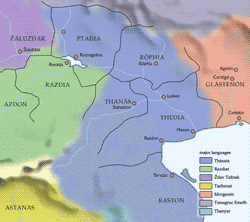![]()
![]()
Introduction - Where Tháxata is spoken, who speaks it, and a little about how this description is oriented.
Phonology & Writing - The sounds of Tháxata, and how to write them.
Morphology - The forms of nouns, verbs, adjectives, and pronouns.
Syntax - How to form larger units, word order, prepositional phrases, relative clauses, and sentences.
Reference - Some useful lists such as numbers, colors, geographical terms.
Dictionary - Tháxata words with English descriptions.
Works in Tháxata - There is an edition of this description in Tháxata (not yet online), and several texts in progress.
![]()
 Tháxata
is spoken by nearly 1 million people in the wide valley of Celesír
(Kelexilia), mainly in the five Torantine kingdoms of Ptadia, Röphia,
Thanäs, Thedia, and Raston. A substantial number of Tháxata speakers
live in neighboring kingdoms as well. The language has become established
throughout Celesír as a diplomatic and trade language, used everywhere
for this purpose except in the east, where Glástenón Trade Pidgin
is the language of trade.
Tháxata
is spoken by nearly 1 million people in the wide valley of Celesír
(Kelexilia), mainly in the five Torantine kingdoms of Ptadia, Röphia,
Thanäs, Thedia, and Raston. A substantial number of Tháxata speakers
live in neighboring kingdoms as well. The language has become established
throughout Celesír as a diplomatic and trade language, used everywhere
for this purpose except in the east, where Glástenón Trade Pidgin
is the language of trade.
Other languages in the area include Razdiat to the west, perhaps the nearest relative of Tháxata; Zhdav Tazhnak and Tazhenat, more distant relatives; and also Tunugruc and Morgenón, which are not related. As mentioned above, Glástenón Trade Pidgin is spoken in the east. It is a pidgin language derived greatly from a combination of Tháxata and Morgenón.
Merchants from the powerful state of Thedia travel all across the eastern seas, making Tháxata one of the most widely known languages in the world. Its status as a language has been tied to the fortunes of Ptadia and Thedia, as they competed with neighboring states over land. For a time, Razdiat was the principal language of the region, but Razdia was weakened by invasions from the west, and Ptadia gained the upper hand.
About the Toran
The history of the Torantine people goes back over a thousand years, back before the great kingdoms were founded. They share a common ancestry with the Razdir and the Zhurtir in the west. In earlier times, they ranged to the far eastern end of Glástenon, but that region was conquered by the Shepherd People, who settled down and took up much of the Torantine way of life.
At this time, learning is held in high esteem in the great cities, and the Toran are studying all aspects of the world around them. The grammarians of Röphia, one of the foremost centers of learning, have analyzed and studied the workings of their language, and have promoted their views of it across the region. This description of Tháxata is a translation of the relevant parts of Zedon Thaxatia (the Art of Language), an authoritative text on the language of the Toran.
![]()
© 2003 J. J. Fatula, III, all rights reserved.